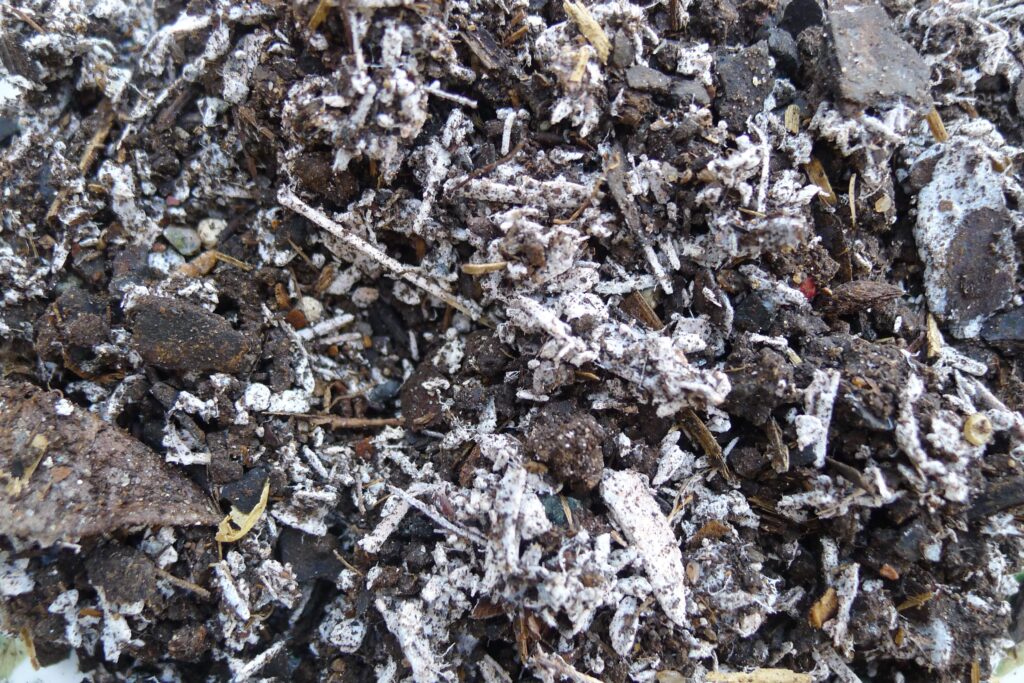
That Weird White Stuff in Your Mulch—Yeah, I Had It Too
A couple summers ago, I walked out into my backyard, coffee in hand, proud of the fresh mulch I’d laid down just a week earlier. Then I saw it—that weird, fluffy white stuff creeping across my flower bed. At first, I thought something spilled, but as I got closer, I realized it looked like some kind of mold or fungus. It was gross, and I had no idea if it was dangerous to me, my kids, or my plants.
If you’ve spotted this strange growth in your own mulch, you’re definitely not alone. I’ve been through it, and luckily, it’s not the end of the world—or your landscaping. Whether it showed up around your new landscaping or even near your backyard privacy plants, this mold is a common headache for homeowners who care about keeping their yards clean and healthy.

What Is That Mold and Is It Dangerous?
So, what exactly is that white or yellow fuzzy stuff? In most cases, it’s something called slime mold or fungal growth. It tends to pop up in warm, wet, and humid conditions—basically, a cozy spa day for mold. It often looks like scrambled eggs or a web of cotton candy. Sounds delightful, right?
But here’s the thing—while it looks nasty, most of the time, this mold isn’t harmful to people or pets. It’s more of a cosmetic issue. I was relieved to learn that it doesn’t usually hurt plants either, though it can indicate your mulch is holding too much moisture or needs better airflow.
I’ll walk you through how I’ve handled it and kept it from coming back—but trust me, no need to panic if you spot it. It’s fixable, and your yard’s still got plenty of life left in it.

Why Does Mulch Mold Even Happen?
This part frustrated me at first because I thought mulch was supposed to make everything look better—not turn my yard into a science experiment. But once I understood why mulch mold happens, it started making more sense. Mold thrives when organic materials (like wood chips) stay damp and don’t get enough airflow. So, if you’ve had a string of rainy days, your sprinklers are hitting the mulch constantly, or you’ve piled it on too thick… bingo, that’s a recipe for fungus.
I made the mistake of laying mulch way too thick that first year—almost 4 inches deep in some spots. I wanted to block weeds and keep moisture in, but instead, I created the perfect mold habitat. Now I stick to about 2 to 3 inches max and make sure it’s not piled up against plant stems or tree trunks. A little spacing goes a long way.

What You Can Do About It (Without Freaking Out)
Here’s what worked for me: first, I grabbed a small rake and gently loosened up the moldy area to help it dry out. You don’t want to dig deep—just break the surface a little to get the air flowing. In some cases, the mold dries up and disappears on its own once the weather changes.
If you want to speed things up, you can scoop out the worst of it and toss it in the trash. Avoid composting moldy mulch unless you’ve got a super hot compost pile that can break it down properly. And don’t be afraid to replace just a patch or two with fresh, dry mulch if it looks bad.
You also don’t need to spray harsh chemicals all over your yard. Mold in mulch is usually just nature doing its thing—not a full-blown infestation. A little patience and airflow usually solve the problem better than a bottle of anything from the hardware store.

Can Moldy Mulch Hurt Your Plants?
This was one of my first concerns when I spotted that fuzzy white stuff creeping across my flower bed. I thought for sure it was going to kill everything. But here’s the deal—most mulch mold is harmless to plants. It might not look great, but it’s more of an eyesore than a threat.
That said, there are a few exceptions. If you’ve got very young or delicate plants, or you’re growing vegetables, you might want to be a little more cautious. Mold can compete for oxygen or trap too much moisture near stems. I make sure to keep mulch about an inch or two away from the base of each plant. That little gap helps everything breathe easier and keeps mold from making itself too cozy.

Is It Safe for Kids, Pets, and You?
Okay, let’s talk real life. I’ve got kids and a dog who think the garden is their personal jungle gym. When mold shows up in mulch, it’s easy to panic. But most of the time, it’s not toxic or dangerous—it’s just part of nature breaking things down.
That said, if you or someone in your home has mold allergies, you’ll want to be a little more proactive. Wear gloves and maybe even a mask when dealing with the mold. I had a small pile near my back patio where we sit and eat dinner in the summer, and I didn’t want spores floating into our food. So, I removed it quickly and replaced that patch with fresh mulch. No big deal—just something to stay aware of.
I also found this helpful when planning other parts of our outdoor setup: Backyard privacy plants that actually work fast. Creating barriers with greenery helps reduce wind and water splash that can make mold worse—plus, it looks great.

When You Should Be Worried About Mulch Mold
Alright, I’ll be honest—most of the time, mulch mold isn’t something to lose sleep over. But there are a few warning signs I always keep an eye on. If the mold has a strong, sour smell (kind of like vinegar or ammonia), or if it spreads fast and starts turning black or slimy, that’s my cue to take action. That could mean your mulch is harboring anaerobic bacteria, which isn’t great for soil health or your plants.
I also look for signs that it’s affecting my plants—wilting leaves, yellowing near the base, or stunted growth. If I notice any of that, I don’t mess around. I’ll remove the worst patches of mold, stir the mulch to dry it out, and sometimes even replace a layer or two. It’s a little work now to save me a headache later.

How to Get Rid of Mulch Mold Without Harsh Chemicals
Here’s where things get hands-on. The easiest fix? Stirring the mulch. Seriously. Just taking a rake to the top layer gets air flowing and helps dry things out. I try to do this every couple of weeks if we’ve had a rainy spell.
If the mold’s really set in, I’ll scrape off the top couple of inches and toss it in the compost bin—away from my main beds. Then I add a thin fresh layer of dry mulch to top it off. Don’t pile it too thick or it’ll trap moisture again.
One tip that changed everything for me? Don’t water your mulch. I focus on watering the base of the plants, not the mulch itself. Less water on top = fewer mold problems. Learned that the hard way.
As an Amazon Associate we earn from qualifying purchases through some links in our articles.



